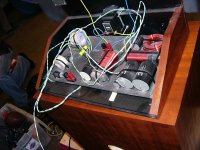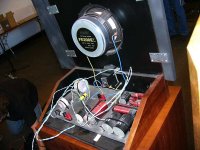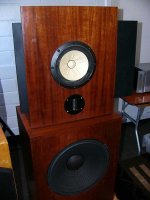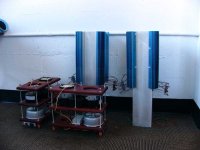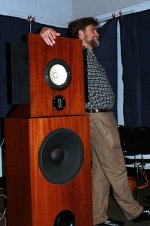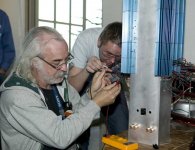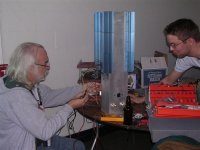Geezers like Totems
and Totems are best when huge
I know one, he made Tower big Amps , with parts dangling on all sides
he was so proud of them, that he show them on one of first BAFs
along with wrinkled Fostex spks
his Licence to Kill is having Iguana name written on

and Totems are best when huge
I know one, he made Tower big Amps , with parts dangling on all sides
he was so proud of them, that he show them on one of first BAFs
along with wrinkled Fostex spks
his Licence to Kill is having Iguana name written on

Last edited by a moderator:
Might be able to add some insight and help things make some sense. More watts are not really needed or even valuable to have if you can learn the relationship of how much power a speaker system needs to make a certain level of sound. Think of them in your industry as the SEER rating. The higher that rating is the less power it takes going in to produce good output.
If you have really high efficiency speakers. You can approach the level of a live rock concert. With about a 2 1/2 watts. You can have normal listening levels with well under a watt.
Variac points out that the Class A amps we favor are both horribly inefficient and run at full blazing power. It sounds better because there is no voodoo to eliminate the crossover distortion of the class A/B Amps. And there is no turning audio into pulses to switch transistors on and off such as the Class D amp mentioned.
Class A. The transistors are turned on fully as soon as power is applied. Pretty much what goes in is what comes out.
The class D amplifiers operate in upwards of 90 percent efficiency. Thats great. But your audio got made into pulses. Sent through filters. Lots of things that just are not natural or linear in nature.
I have a high efficiency air conditioner with the variable speed blower. Pulse widths are great for things like that. Not so much for audio signals. Yeah it can be done and it is done. But for the more discerning listener linear is a better option.
Here is a link to a sound chart. Check out speaker efficiency ratings and find some up around 95 -100 db at a watt. Plug the ACA into that and you might loose the lust for more watts. My "high power" rig is 25 watts of class A. It is ferociously loud and incredibly clear into high efficiency speakers at just 5 watts. The speakers can take the other 20 it has to offer. But it would probably damage our or our animals hearing.
Noise Level Chart: Decibel Levels of Common Sounds With Examples -
If you have really high efficiency speakers. You can approach the level of a live rock concert. With about a 2 1/2 watts. You can have normal listening levels with well under a watt.
Variac points out that the Class A amps we favor are both horribly inefficient and run at full blazing power. It sounds better because there is no voodoo to eliminate the crossover distortion of the class A/B Amps. And there is no turning audio into pulses to switch transistors on and off such as the Class D amp mentioned.
Class A. The transistors are turned on fully as soon as power is applied. Pretty much what goes in is what comes out.
The class D amplifiers operate in upwards of 90 percent efficiency. Thats great. But your audio got made into pulses. Sent through filters. Lots of things that just are not natural or linear in nature.
I have a high efficiency air conditioner with the variable speed blower. Pulse widths are great for things like that. Not so much for audio signals. Yeah it can be done and it is done. But for the more discerning listener linear is a better option.
Here is a link to a sound chart. Check out speaker efficiency ratings and find some up around 95 -100 db at a watt. Plug the ACA into that and you might loose the lust for more watts. My "high power" rig is 25 watts of class A. It is ferociously loud and incredibly clear into high efficiency speakers at just 5 watts. The speakers can take the other 20 it has to offer. But it would probably damage our or our animals hearing.
Noise Level Chart: Decibel Levels of Common Sounds With Examples -
Geezers like Totems
and Totems are best when huge
I know one, he made Tower big Amps , with parts dangling on all sides
he was so proud of them, that he show them on one of first BAFs
along with wrinkled Fostex spks
his Licence to Kill is having Iguana name written on

I know exactly which ones you’re talking about I was at BAFs 2018 and 2019.
But if I were to make it the size would have been miniaturized and you would not even see the cooling.
I can’t wait until I make your Iron Punkin. Finish one or two more of Mr. Passes amps till I feel I’m up to the level to tackle the Mighty Zen Mods vegetables.
Might be able to add some insight and help things make some sense. More watts are not really needed or even valuable to have if you can learn the relationship of how much power a speaker system needs to make a certain level of sound. Think of them in your industry as the SEER rating. The higher that rating is the less power it takes going in to produce good output.
If you have really high efficiency speakers. You can approach the level of a live rock concert. With about a 2 1/2 watts. You can have normal listening levels with well under a watt.
Variac points out that the Class A amps we favor are both horribly inefficient and run at full blazing power. It sounds better because there is no voodoo to eliminate the crossover distortion of the class A/B Amps. And there is no turning audio into pulses to switch transistors on and off such as the Class D amp mentioned.
Class A. The transistors are turned on fully as soon as power is applied. Pretty much what goes in is what comes out.
The class D amplifiers operate in upwards of 90 percent efficiency. Thats great. But your audio got made into pulses. Sent through filters. Lots of things that just are not natural or linear in nature.
I have a high efficiency air conditioner with the variable speed blower. Pulse widths are great for things like that. Not so much for audio signals. Yeah it can be done and it is done. But for the more discerning listener linear is a better option.
Here is a link to a sound chart. Check out speaker efficiency ratings and find some up around 95 -100 db at a watt. Plug the ACA into that and you might loose the lust for more watts. My "high power" rig is 25 watts of class A. It is ferociously loud and incredibly clear into high efficiency speakers at just 5 watts. The speakers can take the other 20 it has to offer. But it would probably damage our or our animals hearing.
Noise Level Chart: Decibel Levels of Common Sounds With Examples -
@ tjw59 100% understand and agree all of Nelson Pass’s websites ( Firstwatt.com, Passlabs.com, Passdiy.com, Zen Mods & planet 10 web sits, and articles I treated like my Bible studies to become a Catholic pope. Like making the Journey to visit Mecca or the Vatican when I attended my first Burning Amp.
When I built my first ACA it was still version 1.1 and after all the reading I also built a set of speakers just for it, the Foster BK-20 because of high efficiency to pair with my amp camp amp.
Now that I have the BA-3 almost completed as a preamp. And the alpha J as my next amp build. I decided it’s time to upgrade my speaker to do it yourself build to complement my alpha J build. This speaker kit from Danny Richie at GR research it’s only $399
YouTube
Just doing the component count on the crossovers alone adding up all the parts if you had to buy them each from Digakey or Mouser They would be more than $399. Then you get 10 drivers on top of that. I don’t think I will have the system finished before Burning Amp Festival 2021 if I do, I may bring it to display since I only live a few minutes away from the firehouse.
Everybody who hears my Amp Camp Amp when visiting my house are blown away by both sound Quality and are amazed when I tell them I’m only pushing 1 W at 90+ DB sound level and I have a DB meter to prove it.
Of course I had to do massive over kill dual mono block linear power supplies for my ACA.
I know exactly which ones you’re talking about I was at BAFs 2018 and 2019.
......
nope Bubba, I was speaking about early BAF time , 2007
these Monstrosities ...........

Attachments
More watts are not really needed or even valuable to have if you can learn the relationship of how much power a speaker system needs to make a certain level of sound.
I often see more power wanted or suggested. I believe, and my experience supports, the notion that it is easier to build a small amp that sounds good.
My 1st experience with the ACA was the 5W/18v diyAudio Store monoBloks. They got hooked up to the speakers already in the system, some 87dB sensitive (with 4Ω bass below 250 Hz), not, in theory a good load for the ACA. Those little amps stayed in the system for a long time… until i got the new stereo version (2x to run bridged). The little amps got quite strained if i wanted to listen quite loud (something i rarely needed).
It is, probably, more important how gracefully an amplifier clips than how big its power rating is — something i learned when we did a shoot-out with an NAD 3020 (20w) and the original Carver Cube (200w) into a benign load (small Maggies). The NAD played louder before audiable strain.
The bridged ACAs turned out to have a high enuff output impedance that the bridged ACAs did not work as well as the less powerful ones that preceded it, probably also the 4Ω load (which looks like 2Ω for each channel when bridged). A SIT-3 came along before i was able to try running them in parallel.
If you really want an amp with big power, i suggest that Class AB (with their almost universal GM droop) or Class D (still an evolving technology — even some 4 decades plus since the 1st Infinity (?) ones i heard in the late 70s (terrible is an adequate descriptor).
The class D amplifiers operate in upwards of 90 percent efficiency.
That is perhaps misleading. To get the 80-90% efficiency numbers one has to use the amplifier near its max power. At more sane levels they wil usually run at it is less.
But your audio got made into pulses. Sent through filters.
This has been Class D’s biggest problems to overcome. They have had issues with how the highest frequencies are reproduced as the pulses affect things lower down. And in many, how that filter works depends on the impedance load of the loudspeaker. Class D has proven to be very good for bass (as long as the loudspeaker is designed to match), but i have yet to hear one that is as good up-top as a good Class A amplifier. Caveat, i have not yet heard the lastest & greatest.
...and find some up around 95 -100 db at a watt.
But do keep in mind that efficiency specs are often choosen by the marketing department, i have seen more than one that is over optimistic by as much as 6dB.
Also with the ACA, especially in bridged mode, the highish output impedance suggests that the loudspeaker needs a flattish impedance curve (ie i would avoid most Klipsch for instance, where impedance is typically quite ugly, and the sensitivity specs are all to often exaggerated)
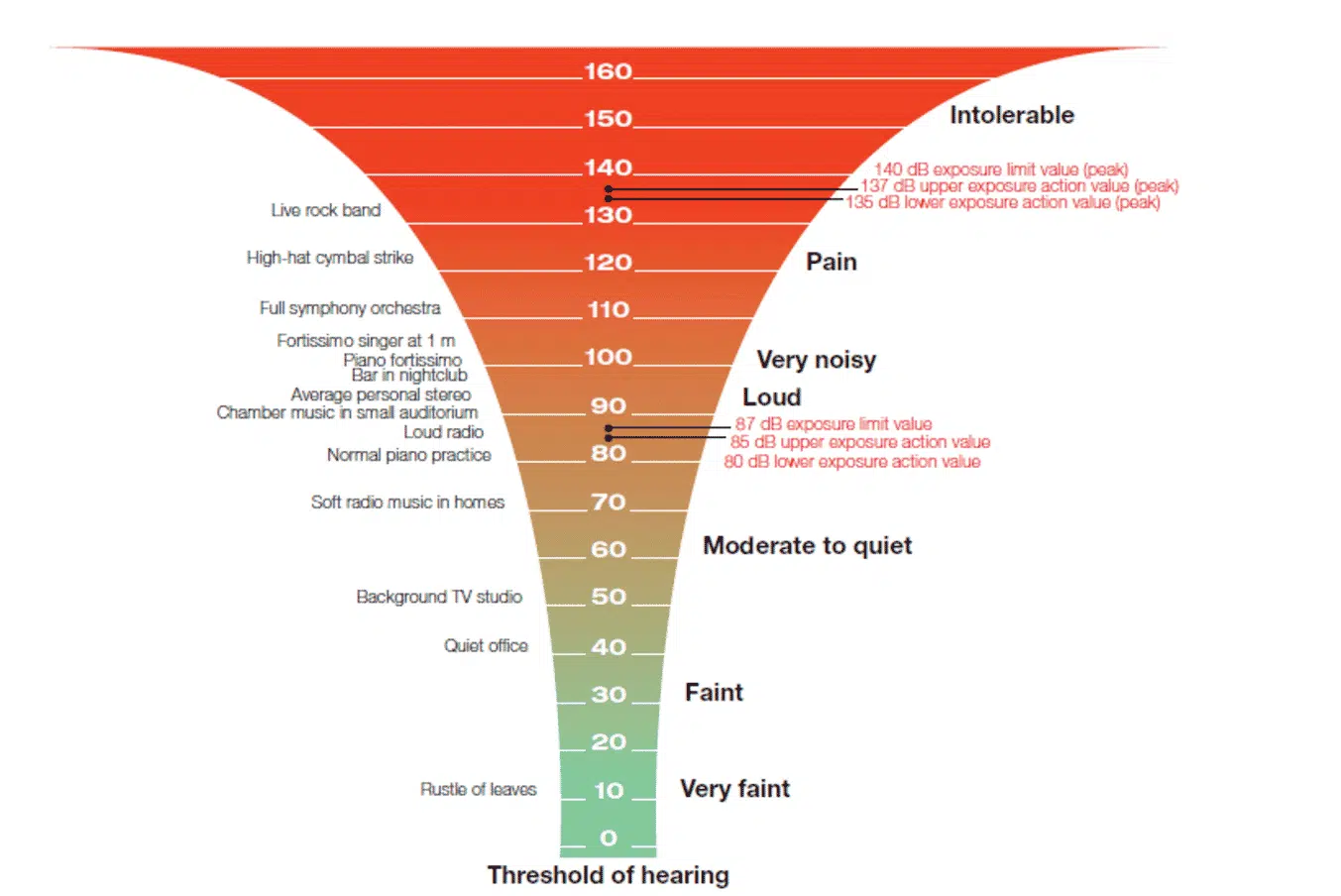
dave
Given the impedance curve (measured here), it is particualrily ugly.

Sensitivity of 90 dB is less than claimed, but 3dB greater than the ones i mostly used with the smaller ACA.
dave

Sensitivity of 90 dB is less than claimed, but 3dB greater than the ones i mostly used with the smaller ACA.
dave
Weirdly that description sounds like me!
A young Scandinavian fellow was staying at my house and insisted amd insisted that the amount of heat sinking I had with the tubular towers wasn’t enough. He then took over and glued the blue heatsinks on. And since there was no time left before the first Burning Amp, he just stuffed the too-long wiring down the hatch! Thanks to all this unexpected work, they weren’t finished at the beginning of the show but in the room behind the main room we had a crack team that included Nelson himself, Jan and Zennie probably. They finished the amps for me and they worked quite well.
Afterward I pointedLy told my heatsink helper “they aren’t very warm” he responded “I thought they were single-ended Class A, not heavily A biased AB”
“Um, thanks a lot Mr. Know it all” I thought, or maybe said.
The days after the show, Jan Didden, another guest, helped me remove the extra sinks, remove the long wires to the MOSFETs and generally rewire it neatly (ish) .
A young Scandinavian fellow was staying at my house and insisted amd insisted that the amount of heat sinking I had with the tubular towers wasn’t enough. He then took over and glued the blue heatsinks on. And since there was no time left before the first Burning Amp, he just stuffed the too-long wiring down the hatch! Thanks to all this unexpected work, they weren’t finished at the beginning of the show but in the room behind the main room we had a crack team that included Nelson himself, Jan and Zennie probably. They finished the amps for me and they worked quite well.
Afterward I pointedLy told my heatsink helper “they aren’t very warm” he responded “I thought they were single-ended Class A, not heavily A biased AB”
“Um, thanks a lot Mr. Know it all” I thought, or maybe said.
The days after the show, Jan Didden, another guest, helped me remove the extra sinks, remove the long wires to the MOSFETs and generally rewire it neatly (ish) .
nope Bubba, I was speaking about early BAF time , 2007
these Monstrosities ...........
Last edited:
Of course you’re Right! I remember that first time you came. We still had the dinner the night before for the Special Invited Guests!
naah Mighty Moi
ZM started Californicatingin 2011
I remember Stereophile , start of 2012 , had tripled printing , just because of mentioning Mighty ZM

...in the room behind the main room we had a crack team that included Nelson himself, Jan and Zennie probably. They finished the amps for me and they worked quite well...
I wish I could find the memory card from that event. I have (had) a cool backlit picture of Nelson working on your amp. Stuart was also around, and IIRC, assisting the Master.
I think Vladimir ended up with all of my jpegs that he posted to the old BAF site.
When this happened to me. I found it to be the power supply connector on the back panel. It was pretty much a low resistance connection between the center conductor and the case. Was my fault. I overheated it when I put the amp together and after a couple of weeks it failed the rest of the way.
My fix was to take the connector socket out. Cut the plug off of the supply cord and passed the lead through the hole and soldered it inside right at the switch. On my second mono block I got really fancy and put a grommet around the lead. The proper way of course is to replace the connector. But that wastes valuable listening time... : )
Hope this helps? May not be the issue at all but the symptoms are identical.
So I popped open my amp and my parts box and I had an extra power supply jack that I installed. I also tried to carefully inspect everything and cleaned up a couple of the solder joints that were maybe questionable. When I reassembled everything, I have the exact same problem as described above.
I have attached some photos in the event that someone with eagle eyes can find Waldo (or the issue). I also have a 10 second video showing how all the lights (including from the power supply unit) dim on and off.
I presume it has to be the switch? Or something on the back panel because both lights dim when the power cuts? If it was an issue with one of the boards would only one light dim?
Such a bummer because this these amps have been solid for a long time now.
Thanks for any input you can provide.
Jim.
Attachments
-
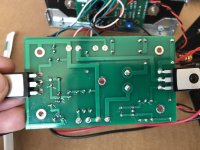 IMG_7796.jpg752 KB · Views: 292
IMG_7796.jpg752 KB · Views: 292 -
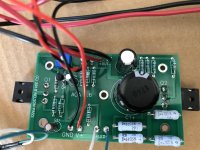 IMG_7797.jpg975.4 KB · Views: 284
IMG_7797.jpg975.4 KB · Views: 284 -
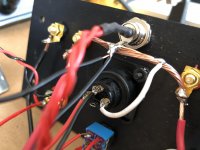 IMG_7799.jpg771.5 KB · Views: 135
IMG_7799.jpg771.5 KB · Views: 135 -
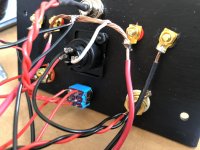 IMG_7800.jpg879.2 KB · Views: 121
IMG_7800.jpg879.2 KB · Views: 121 -
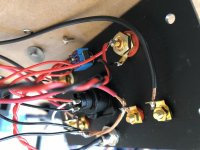 IMG_7801.jpg840.8 KB · Views: 115
IMG_7801.jpg840.8 KB · Views: 115 -
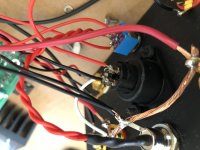 IMG_7802.jpg771.5 KB · Views: 108
IMG_7802.jpg771.5 KB · Views: 108 -
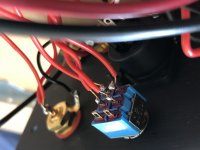 IMG_7805.jpg602.9 KB · Views: 105
IMG_7805.jpg602.9 KB · Views: 105 -
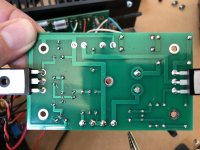 IMG_7808.jpg705.3 KB · Views: 116
IMG_7808.jpg705.3 KB · Views: 116 -
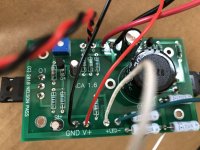 IMG_7809.jpg848 KB · Views: 129
IMG_7809.jpg848 KB · Views: 129 -
IMG_7812.mp46.8 MB
When you lose power, is the power supply light still on?
Yes. It may be difficult to see in the video, but both LEDS on the amp and the light on the power supply dim at the same time. Note that all lights dim, but do not go out completely.
The power supply will keep a dim light for an incredible period of time after unplugging. Can you recreate this with consistency? If using a power strip, have you tried plugging in directly to outlet?
Thanks for the reply. I can’t recreate it in so much that it just keeps happening randomly, but it consistently happens within a minute or so of plugging it in. I have tried it in multiple outlets and it happens the same. Most recently, it was not hooked up to anything. Just plugged in to the outlet.
- Home
- Amplifiers
- Pass Labs
- Amp Camp Amp - ACA
